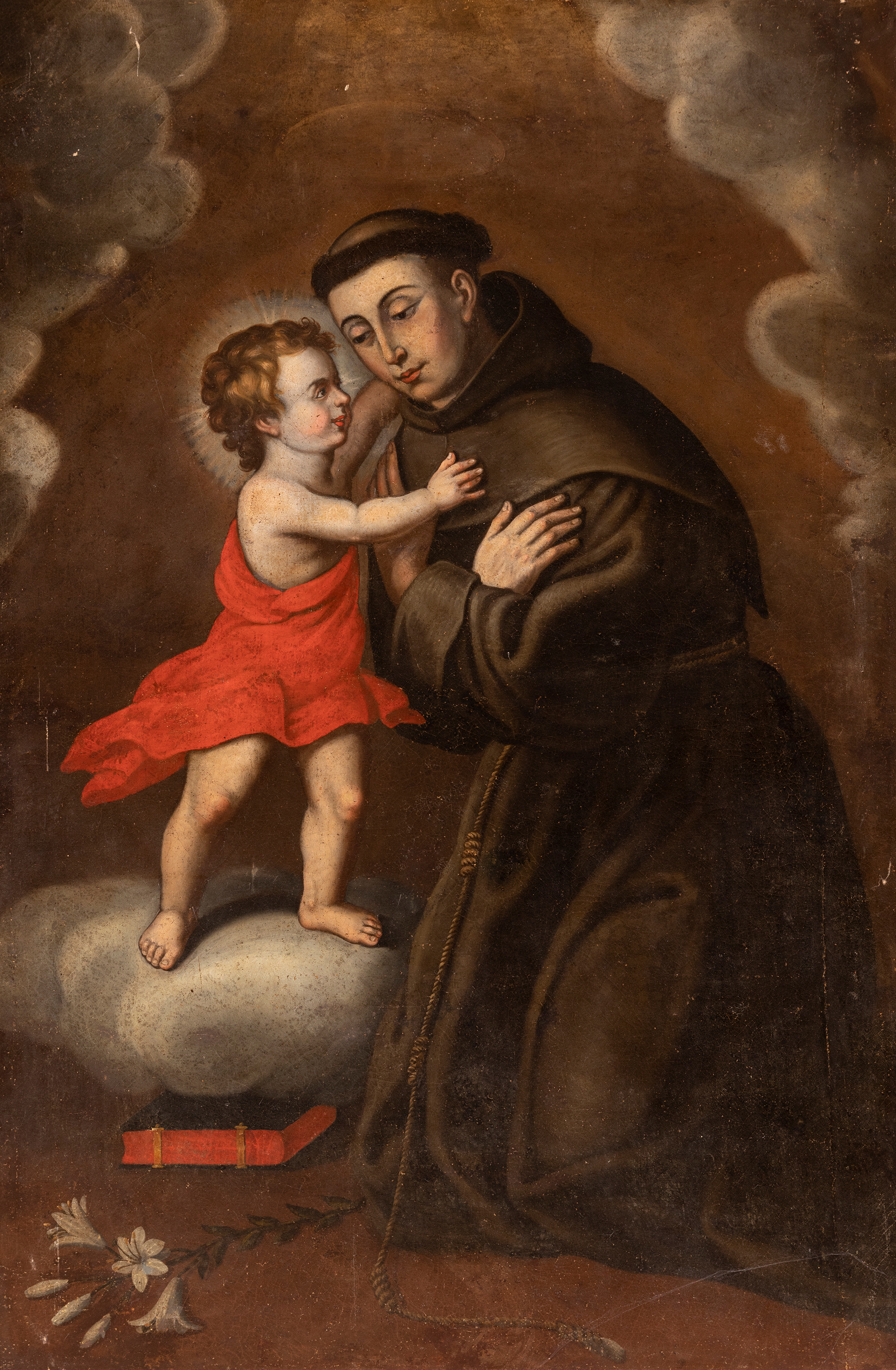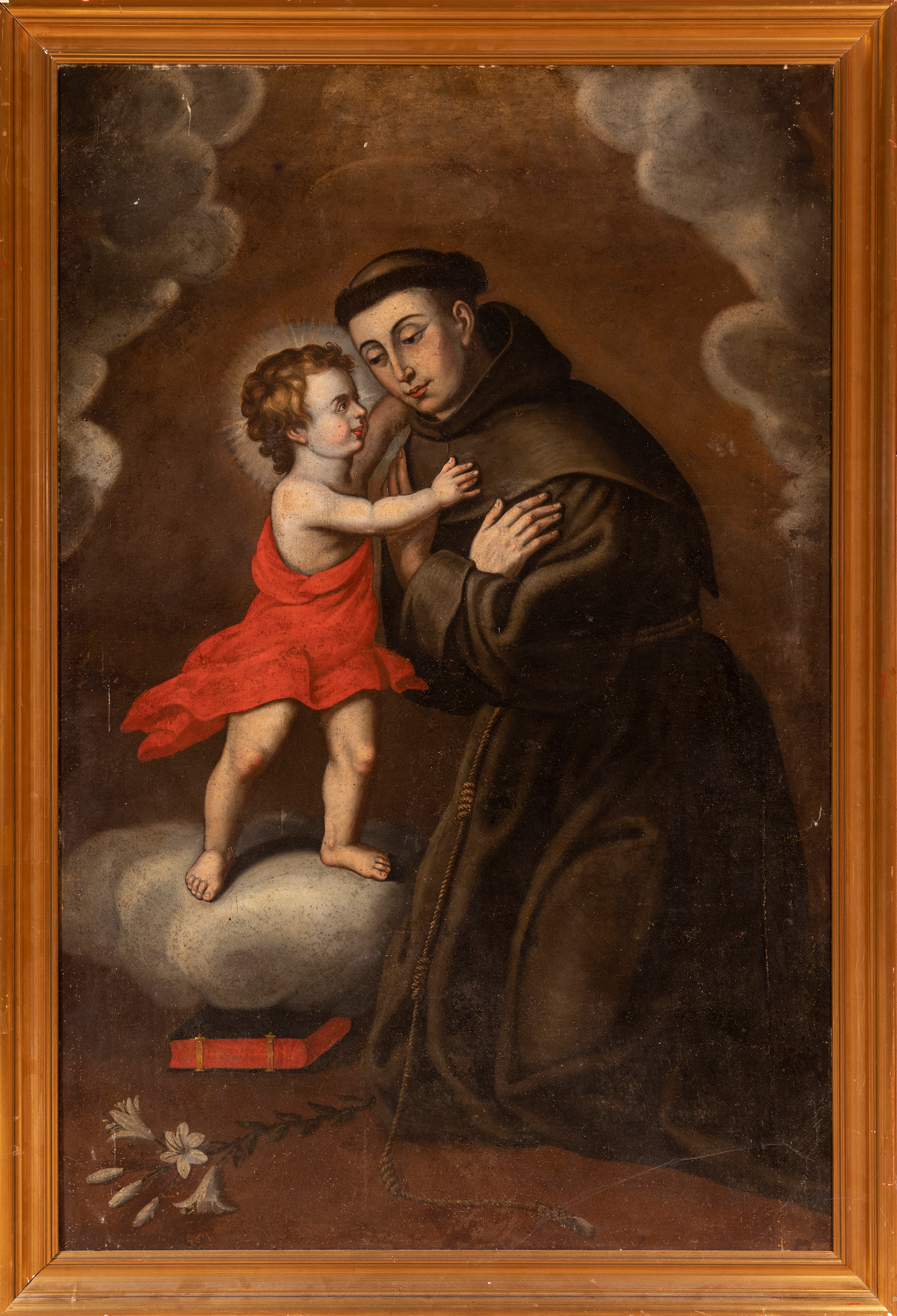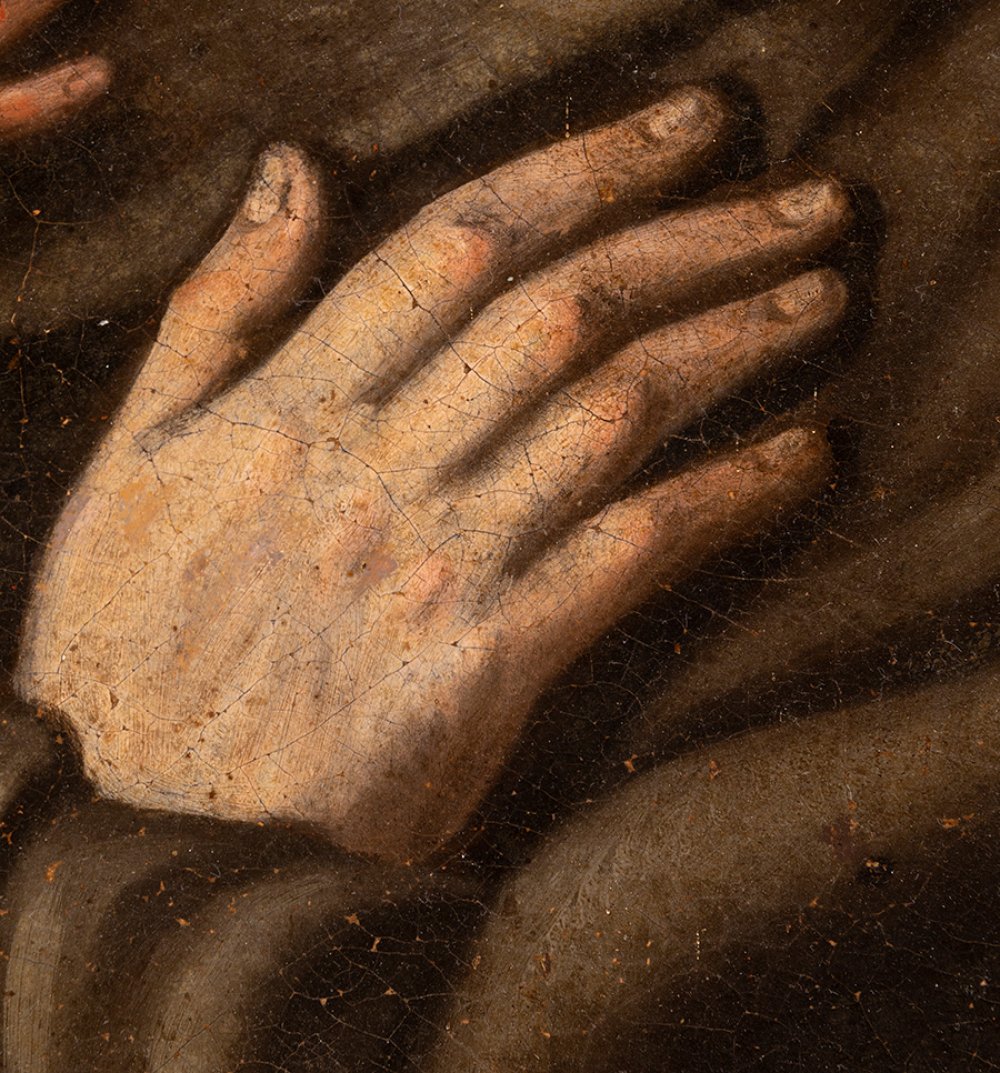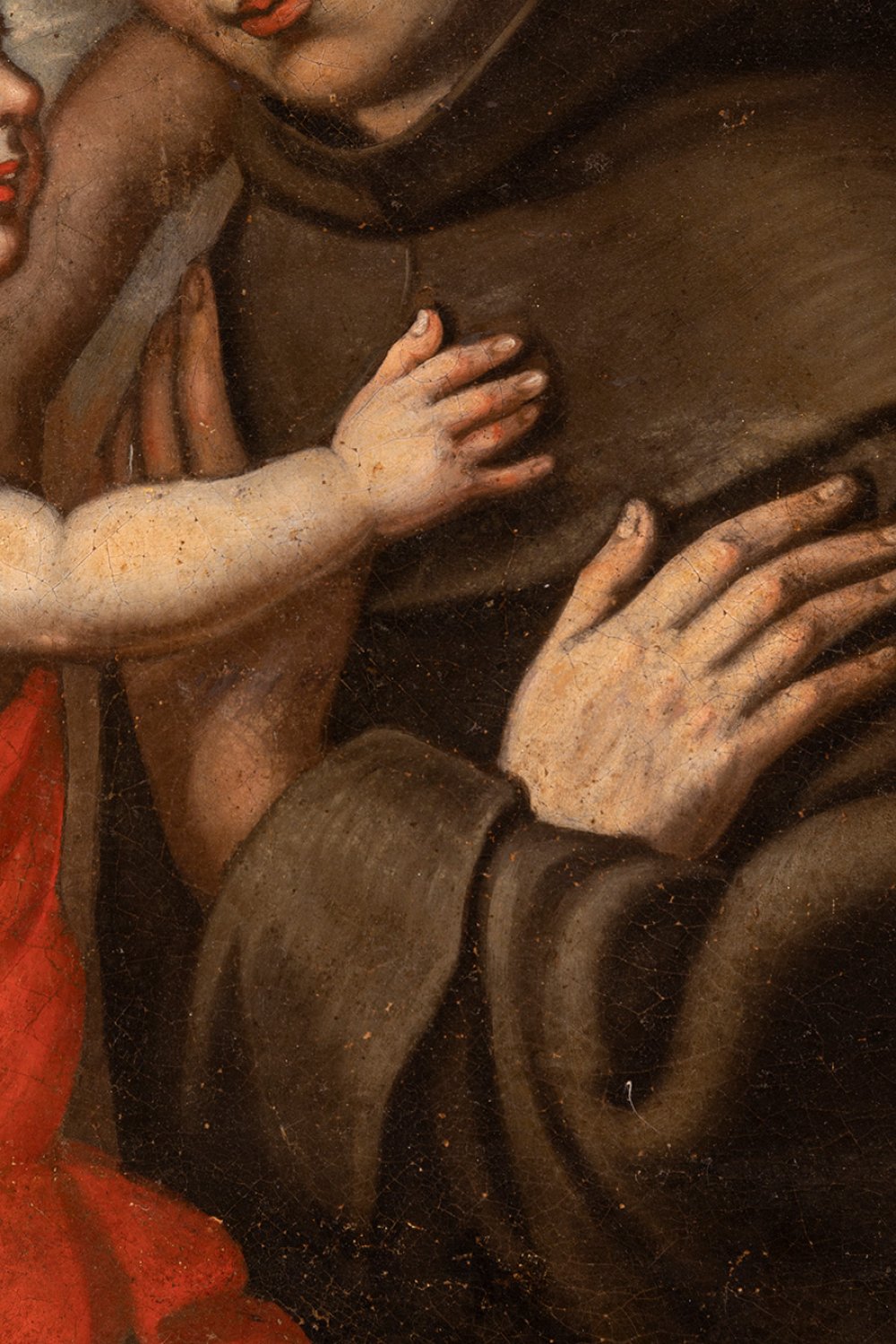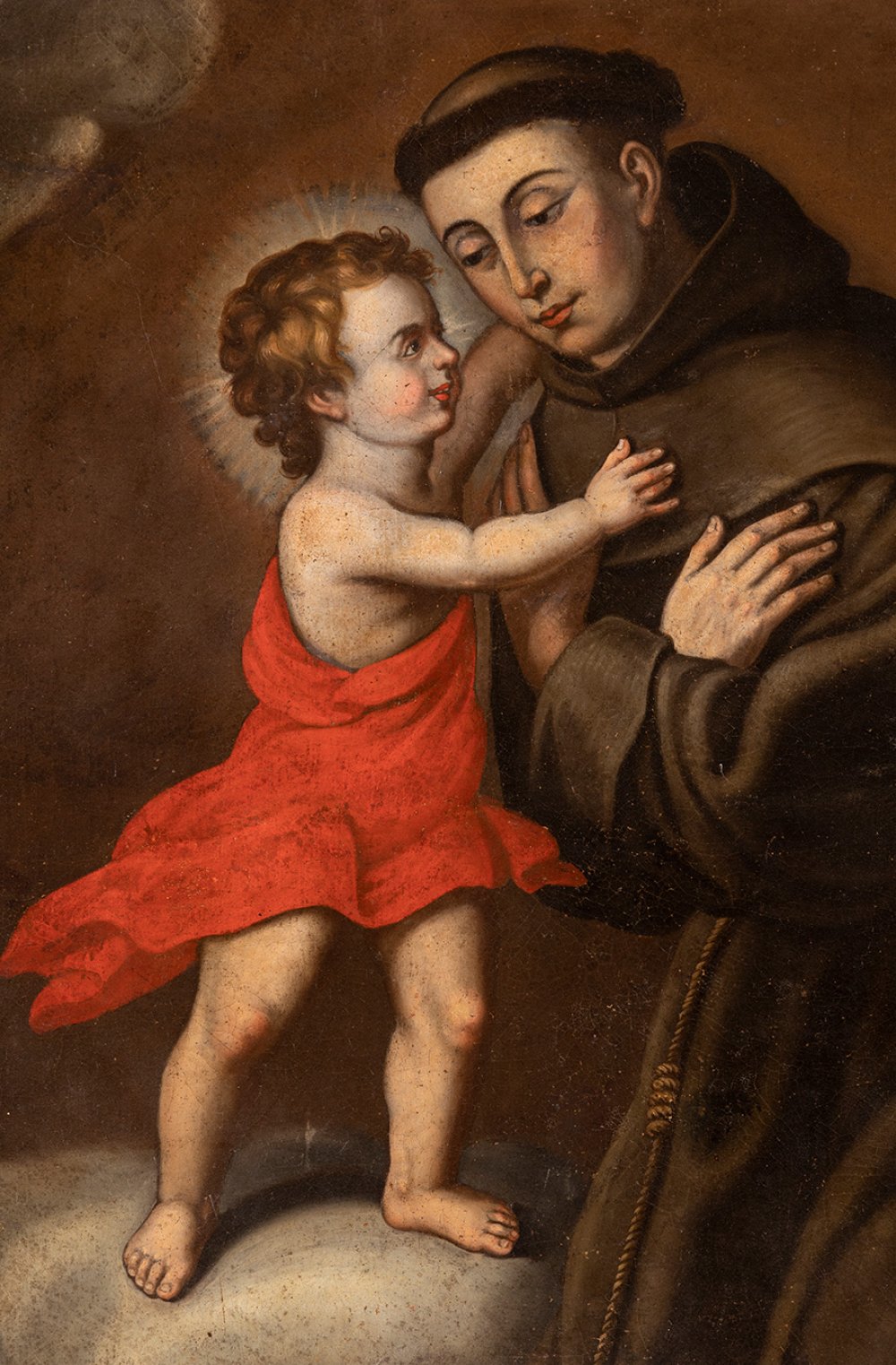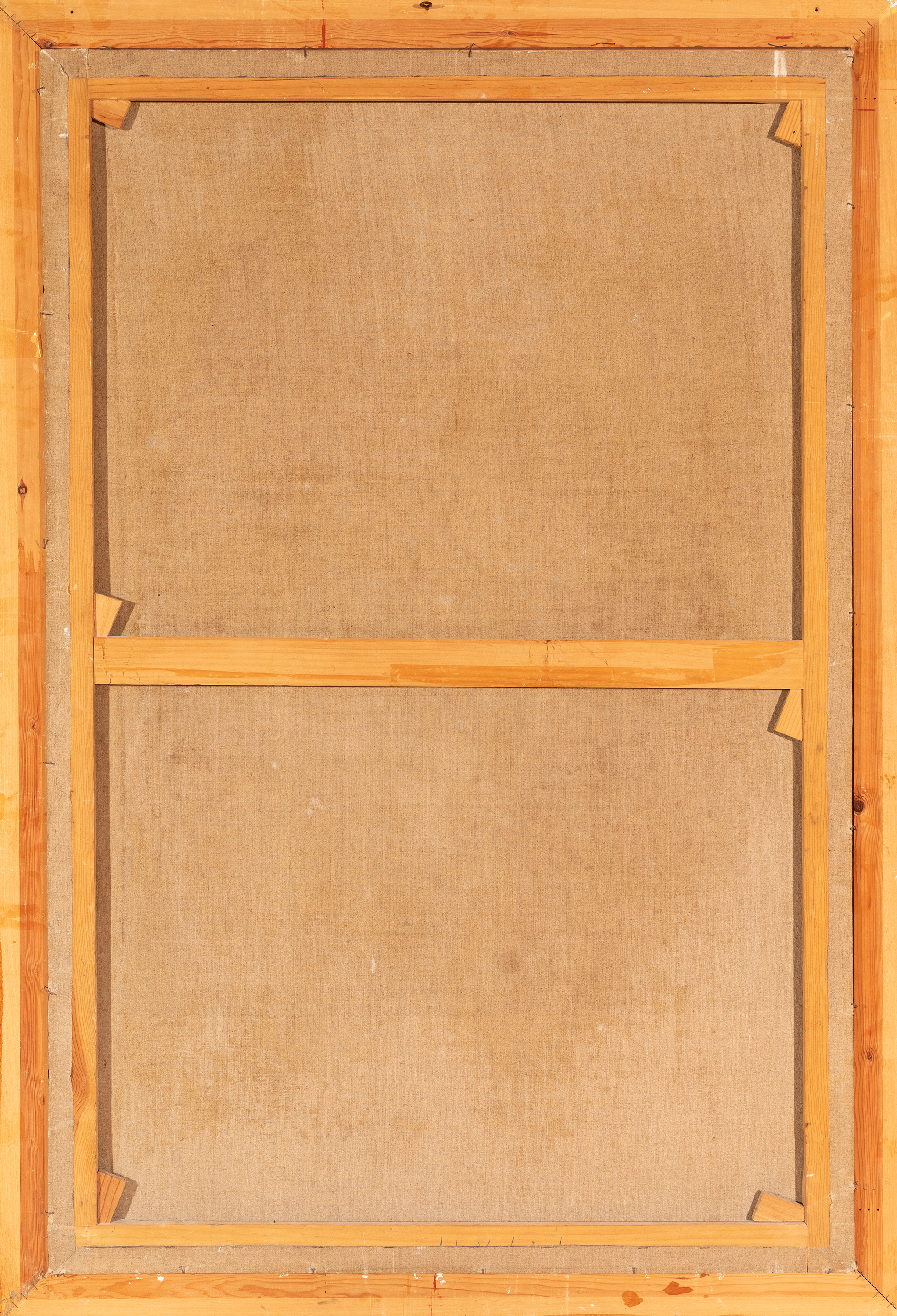57
17th century Spanish school."Saint Anthony of Padua with Child".Oil on canvas. Relined.Measurements:
"Saint Anthony of Padua with Child".
Oil on canvas. Relined.
Measurements: 147 x 97 cm; 161 x 110 cm (frame).
The present canvas represents Saint Anthony of Padua as a young beardless boy with a wide monastic tonsure, dressed in a long Franciscan habit, kneeling in front of Jesus. The presence of the infant, which alludes to the vision he had in his cell, became the most popular attribute of this Franciscan saint from the 16th century onwards, and was particularly popular in the Baroque art of the Counter-Reformation.
Saint Anthony of Padua is, after Saint Francis of Assisi, the most popular of the Franciscan saints. He was born in Lisbon in 1195 and only spent the last two years of his life in Padua. After studying at the convent of Santa Cruz in Coimbra, he entered the Order of Friars Minor in 1220, where he changed his Christian name from Fernando to Antonio. After teaching theology in Bologna, he travelled through southern and central France, preaching in Arles, Montpellier, Puy, Limoges and Bourges. In 1227 he took part in the general chapter at Assisi. In 1230 he was involved in the transfer of the remains of St Francis. He preached in Padua and died there at the age of 36 in 1231. He was canonised only a year after his death, in 1232. Until the end of the 15th century, the cult of St. Anthony remained localised in Padua. From the following century onwards, he became, at first, the national saint of the Portuguese, who placed the churches they built abroad under his patronage, and then a universal saint. He was invoked for the rescue of shipwrecked sailors and the liberation of prisoners. Portuguese sailors invoked him for good wind in the sails, fixing his image on the mast of the ship. Nowadays he is invoked above all to recover lost objects. However, there is no trace of this last patronage before the 17th century. It seems to be due to a play on words with his name: he was called Antonio de Pade or de Pave, an abbreviation of Padua (Padova). From there, he was attributed with the gift of recovering epaves, i.e. lost property. He is depicted as a beardless young man with a broad monastic tonsure, dressed in a habit, and often appears with the Infant Jesus, holding him in his arms, alluding to an apparition he had in his cell. It became the most popular attribute of this saint from the 16th century onwards, being especially popular in the Baroque art of the Counter-Reformation.
"Saint Anthony of Padua with Child".
Oil on canvas. Relined.
Measurements: 147 x 97 cm; 161 x 110 cm (frame).
The present canvas represents Saint Anthony of Padua as a young beardless boy with a wide monastic tonsure, dressed in a long Franciscan habit, kneeling in front of Jesus. The presence of the infant, which alludes to the vision he had in his cell, became the most popular attribute of this Franciscan saint from the 16th century onwards, and was particularly popular in the Baroque art of the Counter-Reformation.
Saint Anthony of Padua is, after Saint Francis of Assisi, the most popular of the Franciscan saints. He was born in Lisbon in 1195 and only spent the last two years of his life in Padua. After studying at the convent of Santa Cruz in Coimbra, he entered the Order of Friars Minor in 1220, where he changed his Christian name from Fernando to Antonio. After teaching theology in Bologna, he travelled through southern and central France, preaching in Arles, Montpellier, Puy, Limoges and Bourges. In 1227 he took part in the general chapter at Assisi. In 1230 he was involved in the transfer of the remains of St Francis. He preached in Padua and died there at the age of 36 in 1231. He was canonised only a year after his death, in 1232. Until the end of the 15th century, the cult of St. Anthony remained localised in Padua. From the following century onwards, he became, at first, the national saint of the Portuguese, who placed the churches they built abroad under his patronage, and then a universal saint. He was invoked for the rescue of shipwrecked sailors and the liberation of prisoners. Portuguese sailors invoked him for good wind in the sails, fixing his image on the mast of the ship. Nowadays he is invoked above all to recover lost objects. However, there is no trace of this last patronage before the 17th century. It seems to be due to a play on words with his name: he was called Antonio de Pade or de Pave, an abbreviation of Padua (Padova). From there, he was attributed with the gift of recovering epaves, i.e. lost property. He is depicted as a beardless young man with a broad monastic tonsure, dressed in a habit, and often appears with the Infant Jesus, holding him in his arms, alluding to an apparition he had in his cell. It became the most popular attribute of this saint from the 16th century onwards, being especially popular in the Baroque art of the Counter-Reformation.
9th November - Old Masters
Sale Date(s)
Venue Address
General delivery information available from the auctioneer
Setdart offers Worldwide shipping
PICK UP IN ROOM: You can come and pick up your lots in our offices (Barcelona, Madrid or Valencia). At the moment of the withdrawal, you will be able to accept the current conditions of the lot by means of a document that you will sign.
YOU CAN SEND ANOTHER PERSON TO PICK UP: This person must present a signed authorization that you can find in our web page by accessing from BUY AT SETDART- LOGISTICS-DOWNLOAD AUTHORIZATION DOCUMENT. You can also send an e-mail with the requested data in AUTHORIZATION DOCUMENT to admin@setdart.com
Important Information
25% buyer´s premium
OR
21% buyer´s premium at www.setdart.com
Terms & Conditions
The maximum period to pay the lots is 7 working days. You can pay either via bank transfer or with credit card through our platform www.setdart.com (we only accept VISA or Mastercard).
BUYER´S PREMIUM: 22% Hammer price + 21% VAT from the buyer´s premium
If your piece has more than 100 years, our Ministry of Culture requires an export certificate in order for the piece to leave the country. Note that if the piece goes inside the EU, there is no cost for the export certificate. If the piece goes outside the EU, there is a cost for the export certificate. You can find more information in our Ministry of Culture website: https://www.culturaydeporte.gob.es/en/cultura/patrimonio/exportacionimportacion/exportacion/tasas.html
INQUIRIES: admin@setdart.com
Setdart guides you through the entire process, from the time of award to the day you receive your lot. Our logistics team will be happy to manage your transport, and will advise you on the best shipping method with professionals from the sector used to handling works of art and jewelry.
WE OFFER WORLDWIDE DOOR TO DOOR SHIPPING
PICK UP IN ROOM: You can come and pick up your lots in our offices. At the moment of the withdrawal, you will be able to accept the current conditions of the lot by means of a document that you will sign.
YOU CAN SEND ANOTHER PERSON TO PICK UP: This person must present a signed authorization that you can find in our web page by accessing from BUY AT SETDART-LOGISTICS-DOWNLOAD AUTHORIZATION DOCUMENT. You can also send an e-mail with the requested data in AUTHORIZATION DOCUMENT to admin@setdart.com
SETDART IS NOT RESPONSIBLE FOR THE STATE OF THE PARTS ONCE THEY LEAVE OUR FACILITIES. MRW SHIPMENTS: Once the payment is made, your lot will be packed for shipment, the logistics department will send you an e-mail notifying you of the day it leaves our warehouse, changes of address cannot be made after receiving this e-mail.
INSURANCE INCIDENTS: Coverage for the value of the auction up to 3000 ? per shipment, if the value of the auction is higher, Setdart will send you a quote including the additional insurance. The insurance company WILL NOT BE RESPONSIBLE FOR THE SHIPMENT THAT EXCEEDS THAT AMOUNT AND IS NOT FULLY INSURED. MRW INCIDENTS: Maximum notification 48 hours after receipt, after which the insurance company WILL NOT BE RESPONSIBLE AND NO CLAIMS WILL BE ACCEPTED.
E-MAIL LOGISTICS: logistica@setdart.com
PICK UP YOUR MESSAGES: You can send your own messaging, prior notice via e-mail that your shipment is ready, please note 3 or 4 days in advance. This type of shipment is packaged so Setdart will provide you with a quote.
EXPENSES FOR STORAGE: We inform you that if the purchased lot is not picked up within a month, you will be charged 30€ per week per lot. Setdart Online S.L., owner of the web site "setdart.com", "setdart.net" and "setdart.org", acts as a company of Spanish nationality inscribed in the Volume 36955, sheet 182, page B-293056 of the Mercantile Registry, with registered office at Calle Aragó













